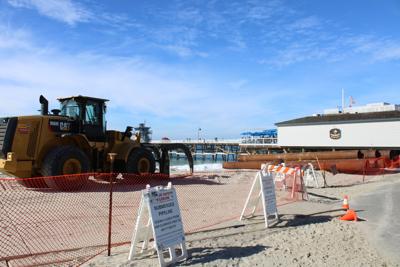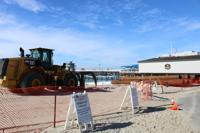Sand placement operations for the San Clemente Shoreline Project are anticipated to resume near the end of April, as the City Council’s approval of a project modification on Tuesday night, March 19, continued the path toward the project’s restart.
The council unanimously voted for numerous actions that included adding a second borrow site to the project, known as Surfside Sunset in northern Orange County, and authorizing entry into a Lease Amendment with the California State Lands Commission. The commission will hear the item at its next meeting on April 4, according to Leslea Meyerhoff, the city’s contracted Coastal Administrator.
Meyerhoff told the council on Tuesday that city staff, the Army Corps, and California State Parks have worked diligently since the project’s suspension to find a new borrow site. She herself also worked to obtain the necessary permits from several entities, including the California Coastal Commission, the California Department of Fish and Wildlife, and the California Office of Historic Preservation.
“To get all these government approvals within this time frame is beyond amazing,” said Mayor Victor Cabral, adding that he wanted to compliment Meyerhoff for her work.
The Shoreline Project has been delayed since mid-January, when contractor Manson Construction moved its operations to Solana Beach amid frustrations from San Clemente officials over the quality of sand placed on the city’s main beach. The project had dredged cobble and other materials from the original borrow site near Oceanside, which caused damage to Manson’s own equipment.
“As a result of the operational challenges the USACE contractor encountered at the currently approved borrow site, the USACE proposes to add the Surfside-Sunset offshore borrow area to the Project to allow operational flexibility for the purpose of obtaining beach quality sand for placement along the Project site in San Clemente,” the agenda report read.
Further defining “operational flexibility,” Manson has requested to use equipment 24 hours a day for the project, according to Meyerhoff, instead of the project’s initial hours of 7 a.m. to 7 p.m. The project site will continue to enforce temporary beach closures to protect the public.
Mobilization for the San Clemente project is planned to begin as Manson completes a project in Encinitas, which is anticipated to occur between April 20 and April 24.
Speaking to concerns over whether the sand will wash away immediately after being placed, Meyerhoff said the sand’s function is to serve as the buffer protecting city infrastructure. The Army Corps identified the project’s location between Linda Lane and T-Street as “most optimal in terms of economic benefits,” she added, because of the damages that would be avoided with sand.
The sand is expected to move both up and down the coast, and onshore and offshore in different seasons, especially as more sand is added during the life of the 50-year project.
“We won’t see the 50-foot berm, but, say, two weeks after the project is completed, it will have spread out into what’s called an equilibrium profile, and that’s expected,” said Meyerhoff.
The project may also not hold to the slated sand nourishment cycle of every six years, depending on how the beach performs as determined by shoreline monitoring.
Given the city will need to have the funding to foot its 50% share of project costs going forward whenever sand needs to be placed next, Meyerhoff emphasized the need for a citywide beach nourishment program that can also build on the Army Corps project.


